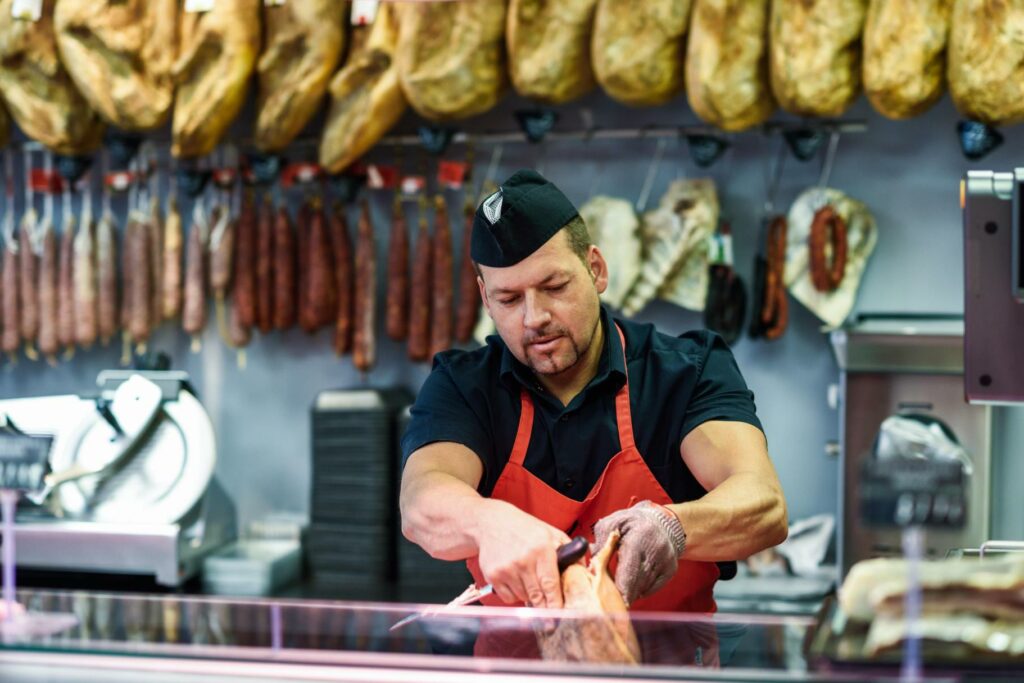Ham boning is an artisanal process that requires skill and precision to extract the different parts of the ham without compromising its quality or appearance. This procedure is carried out in order to facilitate the cutting and presentation of the ham, as well as to make the most of its meat.
At César Nieto Group we have boneless ham ready for sale and to eat directly. A high quality end product that preserves all the flavor and tradition of authentic Iberian ham, ready to be enjoyed on any special occasion.
What is ham boning?
Ham boning consists of removing the main bone of the ham, as well as other smaller bones that may be present in the piece. This is done using sharp tools and specific techniques to separate the bone from the meat without damaging the structure of the ham.
Once the bone has been removed, the ham is ready for slicing and consumption. By removing the bone, the slicing process is facilitated, making it possible to obtain thin, uniform slices of meat. In addition, deboning the ham can facilitate transportation and storage, since it reduces the risk of breakage or damage during handling.
Ham boning is a delicate process that requires skill and experience to be carried out successfully. Good deboning ensures that the ham retains its natural shape and attractive appearance, keeping its flavor and quality intact.
Why is ham boning done?
Ham boning is an important step in the preparation of this delicious piece of meat, allowing its flavor and texture to be fully enjoyed in every bite. Ham boning is done for several main reasons:
- Facilitates slicing and handling: By eliminating the ham bone, the slicing process is considerably facilitated. This makes it possible to obtain thin, uniform slices of meat, which improves the ham’s presentation and facilitates its consumption.
- Maximum use of the meat: Boning the ham allows maximum use to be made of the meat in the piece. By eliminating the bone, it ensures that no meat remains attached to it, which means that all the meat can be used.
- Facilitates transport and storage: By eliminating the bone, the ham becomes more compact and easier to handle, making it easier to transport and store. This is especially useful in the case of hams that are sold sliced or vacuum-packed.
- Improves product presentation: A boneless ham has a cleaner and more attractive appearance, which can be more appealing to the consumer.
Boning ham at César Nieto
At César Nieto we are very meticulous when boning ham. The first step is to remove the outer skin, revealing the meat underneath. Next, the main bone is removed from the ham, using sharp tools and specific techniques to separate it from the meat cleanly and precisely.
Once the main bone has been removed, other parts of the ham can be extracted, such as the hip bone and the tip bone. These bones are usually smaller and more delicately embedded in the meat, so greater skill and care is required to remove them without damaging the structure of the ham.
Ham boning involves the removal of the bones and also the elimination of any fatty tissue or membranes that may affect the presentation and flavor of the final product. This process is carried out meticulously, ensuring that the ham retains its natural shape and attractive appearance.
Once deboned, the ham is presented ready for slicing and consumption, either in thin slices to serve as an appetizer or in larger pieces for use in gourmet recipes. Boning the ham facilitates handling and allows to make the most of every part of the ham.
In short, ham boning is a delicate process that requires skill and experience to be carried out successfully. Thanks to this procedure, at César Nieto we obtain a high quality final product that preserves all the flavor and tradition of authentic Iberian ham. Try it and treat yourself to the best ham.
